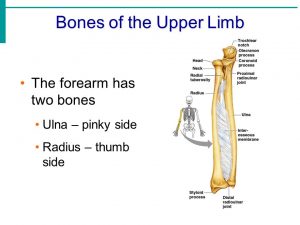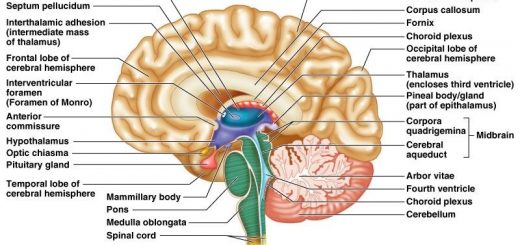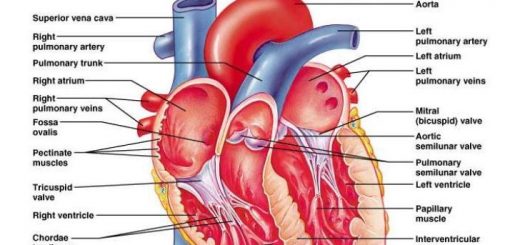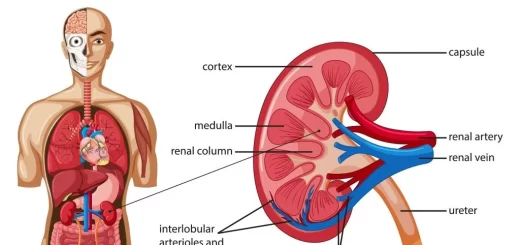Bones of upper limb structure, function, types & anatomy
Bones protect our vital organs and allow us to move. they act as a storage area for minerals, particularly calcium, they serve as a reservoir for calcium and phosphorus, essential minerals for various cellular activities throughout the body.
Bones of upper limb
The bones of the upper limb consist of:
- Bones of the shoulder girdle: Clavicle (Anteriorly), and Scapula (Posteriorly).
- The bone of the arm: Humerus
- Bones of the forearm: Radius (situated laterally), and Ulna (situated medially).
- Bones of the hand: 8 carpal bones, 5 metacarpal bones are bones of the palm, and Phalanges: bones of the fingers (each finger has 3 except thumb has 2 phalanges).
Clavicle
The clavicle has a shaft and 2 ends (medial and lateral):
- Medial (Sternal) end is rounded in shape and articulates with the manubrium sterni.
- The lateral (Acromial) end is flattened, articulates with the acromion process of the scapula.
- Shaft has a double curvature; its medial 2/3 is convex anteriorly and its lateral 1/3 is concave anteriorly.
Lateral 1/3 of the shaft
It is flattened and concave anteriorly. It has 2 borders (anterior and posterior). It has 2 surfaces (superior and inferior). Its superior surface is smooth. Its inferior surface is rough and presents:
- Conoid tubercle: close to the posterior border.
- Trapezoid line: extends laterally from the conoid tubercle to the lateral end.
Medical 2/3 of the shaft
It is cylindrical and convex anteriorly. It has 4 surfaces: anterior, posterior, superior, and inferior. The superior surface is smooth. The inferior surface is rough and presents a subclavian groove in its intermediate 1/3 for the insertion of the subclavius muscle.
Identification of the side (Right or left)
- Medical end is rounded lateral end is flattened.
- Superior surface is smooth inferior surface is rough.
- Medical 2/3 of the shaft is convex anteriorly lateral 1/3 is concave anteriorly.
Attachment and ligaments that are attached to the clavicle include:
- The deltoid is attached to the Anterior surface (lateral 1/3).
- The trapezius is attached to the posterior surface (lateral 1/3).
- Pectoralis major is attached to the Anterior surface (medial 1/2).
- Subclavius is attached to the inferior surface (intermediate 1/3).
- Sternomastoid is attached to the superior surface (medial 1/3).
- Coraco-clavicular ligament: Conoid part is attached to Conoid tubercle, Trapezoid part is attached to Trapezoid line.
- The casto-clavicular ligament is attached to the Rough area on the medical end of the inferior surface.
Ossification of the clavicle
It ossified in a membranous ossification. 2 primary centres appear about 5th weak of intrauterine life. One secondary centre for each end appears about the age of 15 years. and it is the first bone in the body to ossify.
Articulations of the clavicle
- The medial end articulates with the manubrium sterni (sternoclavicular joint) and with the 1st costal cartilage.
- The lateral end articulates with the acromion process of the scapula (acromio-clavicular joint).
Clinical notes
The weakest point of the clavicle is the junction between the medical 2/3 and the lateral 1/3. Fracture at this point due to falling on an outstreched upper limb will lead to:
- The lateral segment: is depressed by the weight of the arm.
- The medical segment: is pulled up by the sternomastoid muscle.
Scapula
The scapula is the posterior bone of the shoulder girdle. It is a triangular flat bone. It is situated on the postero-lateral aspect of the thoracic cage. It connects the clavicle with the humerus. It has:
- 2 surfaces: costal (anterior) and dorsal (posterior).
- 3 borders: Medical (vertebral), Lateral (axillary), and Superior.
- 3 angles: superior, inferior, and lateral.
- 3 processes: spine, acromion and coracoid.
- 3 fossae: subscapular, supraspinous, and infraspinous.
- 2 notches: suprascapular, and spinoglenoid.
Surfaces of the scapula
- Costal surface is concave forming the subscapular fossa.
- The dorsal surface is divided into supraspinous fossa and infraspinous fossa by the spine.
Borders of the scapula
- The superior border is the shortest border. It presents a suprascapular notch close to the coracoid process. The suprascapular notch is transformed into a foramen by means of the suprascapular ligament. Suprascapular vessels pass above the suprascapular ligament. The suprascapular nerve passes through the foramen.
- Medial (vertebral) border is the longest border. It lies parallel to the vertebral column.
- Lateral (axillary) border is the thickest border.
Angles of the scapula
- The superior angle lies at the junction between the superior and medial borders, opposite the 2nd rib.
- The inferior angle lies at the junction between the medial and lateral borders, opposite the 7th rib.
- The lateral angle lies at the junction between the superior and lateral borders. It consists of the head and neck. The head carries a pear-shaped concavity called the glenoid cavity. The glenoid cavity articulates with the head of the humerus (shoulder joint). Labrum glenoidale is a fibrocartilagenous lip, attached to the margin of the glenoid cavity. Supraglenoid tubercle lies above the glenoid cavity. Infraglenoid tubercle lies below the glenoid cavity. The neck of the scapula is a constriction medial to the head of the scapula.
Processes of the scapula
- Spine of the scapula is a triangular shelf-like projection from the dorsal aspect of the scapula. It divides the dorsal surface into supraspinous and infraspinous fossae. Its posterior free border is called the crest of the spine. The crest has superior and inferior lips. The crest presents a rough tubercle close to its medial end (tubercle of the crest of the spine). Spinoglenoid notch lies between the lateral free border of the spine and the glenoid cavity.
- Acromion is the lateral extension of the spine of the scapula. It has medial and lateral borders. Its medial border presents an oval articular facet for articulation with the clavicle.
- Coracoid process looks like a bent finger. It projects from the superior border lateral to the scapular notch. It is directed laterally and forwards. It has a tip, superior and inferior surfaces, and medical & lateral borders.
Identification of the side of the scapula (right or left):
- The glenoid cavity is directed upward and laterally.
- The spine is directed posteriorly.
The Humerus
The humerus is a long bone that has a shaft, upper end, and a lower end.
The upper end
The upper end consists of a head, two tuberosities, and two necks. The head forms less than half a sphere and is directed medially. It is separated from the tuberosities by the anatomical neck. The greater tuberosity is a large projection on the lateral aspect of the upper end. It gives attachments to the following muscles from above downwards: supraspinatus, infraspinatus, and teres minor.
The lesser tuberosity is a small projection on the anterior aspect of the upper end. It gives attachment to the subscapularis muscle. The two tuberosities are separated by an intertubercular groove (bicipital groove) The bicipital groove has a floor, medial lip, and lateral lip. The pectoralis major muscle is attached to the lateral lip.
The Latissimus dorsi is attached to the floor. The Teres major is attached to the medial lip. The long head of the biceps brachii muscle after taking origin from the super-glenoid tubercle of the scapula descends by passing in the bicipital groove. The upper end is separated from the shaft by a constricted part of the bone, the surgical neck.
The shaft
In the middle of the lateral aspect, there is a rough area, the deltoid tuberosity for the insertion of the deltoid muscle. On the middle of the medial aspect is the insertion of the coracobrachialis muscle, and immediately near this area, there is a nutrient foramen.
On the posterior aspect of the shaft, there is a spiral groove that passes downwards and laterally lodging the radial nerve and the profunda brachii vessels. The lateral head of the triceps muscle takes origin from an oblique ridge above the spiral groove, while the medial head takes origin from the lower half of the posterior surface of the humerus. The brachialis muscle takes origin from the lower half of the anterior surface of the humerus.
The lower end
The lower end possesses two articular surfaces (trochlea and capitulum), two epicondyles (medial and lateral), and three fossae (coronoid, radial, and olecrenon). The trochlea is a pully-shaped piece of bone that articulates with the trochlear notch of the ulna in the elbow joint. The capitulum is a small rounded piece of bone that lies lateral to the trochlea. It articulates with the upper surface of the head of the radius in the elbow joint.
The medial and lateral epicondyles are medial and lateral prominences from the lower end of the humerus. The medial is more prominent and carries the common flexor origin (for the flexors that lie in the front of the forearm). It also carries a groove on its posterior aspect for the ulnar nerve. The lateral epicondyle carries the common extensor origin (for the muscles at the back of the forearm).
A supracondylar ridge extends upwards from each epicondyle. The brachioradialis takes origin from the upper two-thirds of the lateral supracondylar ridge, while the extensor carpi radialis longus from its lower third.
The coronoid fossa is the fossa on the anterior surface above the trochlea. It contains the coronoid process of the ulna during flexion of the elbow. The radial fossa lies on the anterior surface above the capitulum. It contains the head of the radius during flexion of the elbow. The olecrenon fossa lies on the posterior surface above the trochlea. It contains the olecrenon process of the ulna during the extension of the elbow.
How can you identify the side, whether right or left?
- Put the head above and medially.
- Put the bicipital groove anteriorly.
Articulation
- Proximally, the head of the humerus articulates with the glenoid cavity of the scapula in the shoulder joint.
- Distally, the capitulum of the humerus articulates with the upper surface of the head of the radius, and the trochlea of the humerus articulates with the trochlear notch of the ulna in the elbow joint.
Nerves related to the humerus
- Radial nerve: passes in the spiral groove. Thus it can be injured in the fractured shaft of the humerus.
- Axillary nerve: passes around the surgical neck of the humerus.
- Ulnar nerve: passes behind the medial epicondyle.
Pectoral Region
The pectoral region is the front of the upper part of the trank. The pectoral region includes:
- Pectoralis major muscle.
- Pectoralis minor muscle.
- Subclavius muscle.
- Clavipectoral fascia.
Pectoralis major muscle
- Origin: 2 heads: Clavicular head: clavicle, front of medical 1/2. Sternocostal head: front of sternum, upper 6 costal cartilages, external oblique aponeurosis.
- Insertion: Humerus, lateral lip of bicipital groove.
- Nerve supply: Brachial plexus, medial & lateral pectoral nerves.
- Action: Adduction & medial rotation of the arm. Flexion of the arm (clavicular head). In the case of fixation of the humerus: It acts as an accessory inspiratory muscle & helps in climbing.
Pectoralis minor
- Origin: Front of the 3rd, 4th, 5th ribs.
- Insertion: Coracoid process, medial & upper aspect.
- Nerve supply: Brachial plexus, and medial pectoral nerve.
- ِAction: Protraction of the scapula. depresses the shoulder, and accessory inspiratory muscle.
Subclavius
- Origin: Upper surface of the 1st costochondral junction.
- Insertion: Clavicle, and subclavius groove.
- Nerve supply: Nerve to subclavius.
- Action: Steadies the clavicle and fixes it to the first rib.
Clavipectoral fascia
It is a membranous layer of deep fascia that extends between the pectoralis minor muscle and subclavius. Superiorly, it splits to enclose the subclavius muscle. Inferiorly, it splits to enclose the pectoralis minor then continues down as the suspensory ligament of the axilla.
The fascia is continuous inferiorly with the axillary fascia. Costocoracoid membrane is the upper part of the clavipectoral fascia which extends between the 1st costal cartilage and the coracoids process.
Structures piercing the clavipectoral fascia:
- Cephalic vein (terminal part).
- Thoraco-acromial artery.
- The lateral pectoral nerve.
- Lymphatic vessels.
Bone (Osseous Tissue) types, structure, function & importance
Bones function, types & structure, The skeleton & Curvature of Spine in Adults
Importance of Anatomical body position, planes & terms of movement
Joints types & function, Nerve supply of joints & general features of Synovial Joints
Back muscle anatomy, types, structure, importance & names
Types of bones, Histological features of compact bone & cancellous bone




